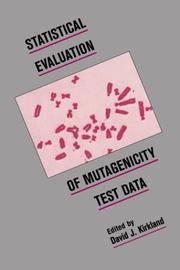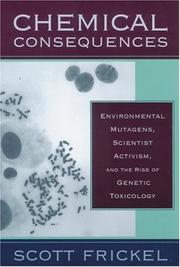Periodical
ISSN: 18729347 Year: 1975 Publisher: Amsterdam, the Netherlands : Elsevier,
Abstract | Keywords | Export | Availability | Bookmark
 Loading...
Loading...Choose an application
- Reference Manager
- EndNote
- RefWorks (Direct export to RefWorks)
Genetic toxicology --- Genetics --- Research --- Genotoxicity --- Genotoxicology --- Toxicology --- Genetic aspects --- Genetic Structures --- Genetic Phenomena --- Biochemical genetics --- Medical genetics --- Carcinogenesis --- Chemical mutagenesis --- Mutagenesis. --- Toxicogenetics.
Periodical
ISSN: 14643804 02678357 Year: 1986 Publisher: Oxford : Oxford University Press
Abstract | Keywords | Export | Availability | Bookmark
 Loading...
Loading...Choose an application
- Reference Manager
- EndNote
- RefWorks (Direct export to RefWorks)
Mutagenesis is an international multi-disciplinary journal designed to bring together research aimed at the identification, characterization and elucidation of the mechanisms of action of physical, chemical and biological agents capable of producing genetic change in living organisms and the study of the consequences of such changes.
Mutagenesis --- Mutagenicity Tests. --- Mutagens. --- Mutagenesis. --- Life Sciences --- Biochemistry --- Genetics --- Biology --- Mutagenese --- Zeitschrift --- Online-Ressource --- Mutagenität --- Life Sciences. --- Genetics. --- Mutagenicity Tests --- Mutagens --- Periodikum --- Zeitschriften --- Tests, Genetic Toxicity --- Toxicity Tests, Genetic --- Genetic Toxicity Tests --- Genotoxicity Tests --- Mutagen Screening --- Genetic Toxicity Test --- Genotoxicity Test --- Mutagen Screenings --- Mutagenicity Test --- Screening, Mutagen --- Screenings, Mutagen --- Test, Genotoxicity --- Tests, Genotoxicity --- Toxicity Test, Genetic --- Gentoxizität --- Genotoxizität --- Mutagene Wirkung --- Gentoxische Wirkung --- Netzpublikation --- Online-Publikation --- Computerdatei im Fernzugriff --- Online-Dokument --- On-line-Dokument --- On-line-Publikation --- Clastogens --- Genotoxins --- Presse --- Fortlaufendes Sammelwerk --- Mutation (Biology) --- Radiogenetics --- Teratogenesis --- Carcinogenicity Tests --- Toxizität --- Gentoxikologie --- Carcinogens --- Mutation --- Elektronische Publikation --- Mutagenität --- Clastogen --- Genotoxin --- Mutagen --- Popular Science and Nature.
Book
ISBN: 0128010061 0128007648 9780128010068 9780128007648 Year: 2016 Publisher: Amsterdam Academic Press is an imprint of Elsevier
Abstract | Keywords | Export | Availability | Bookmark
 Loading...
Loading...Choose an application
- Reference Manager
- EndNote
- RefWorks (Direct export to RefWorks)
Genetic toxicology. --- Mutagenicity testing. --- Mutagen testing --- Mutagenesis --- Mutagens --- Chronic toxicity testing --- Genotoxicity --- Genotoxicology --- Toxicology --- Biochemical genetics --- Medical genetics --- Carcinogenesis --- Chemical mutagenesis --- Testing --- Genetic aspects

ISBN: 0521366054 Year: 1989 Publisher: Cambridge Cambridge University press
Abstract | Keywords | Export | Availability | Bookmark
 Loading...
Loading...Choose an application
- Reference Manager
- EndNote
- RefWorks (Direct export to RefWorks)
Data Interpretation, Statistical. --- Mutagenicity Tests. --- Mutagens --- Mutagenicity testing --- -Mutagen testing --- Mutagenesis --- Chronic toxicity testing --- Tests, Genetic Toxicity --- Toxicity Tests, Genetic --- Genetic Toxicity Tests --- Genotoxicity Tests --- Mutagen Screening --- Genetic Toxicity Test --- Genotoxicity Test --- Mutagen Screenings --- Mutagenicity Test --- Screening, Mutagen --- Screenings, Mutagen --- Test, Genotoxicity --- Tests, Genotoxicity --- Toxicity Test, Genetic --- Carcinogenicity Tests --- Data Interpretations, Statistical --- Interpretation, Statistical Data --- Statistical Data Analysis --- Statistical Data Interpretation --- Data Analysis, Statistical --- Analyses, Statistical Data --- Analysis, Statistical Data --- Data Analyses, Statistical --- Interpretations, Statistical Data --- Statistical Data Analyses --- Statistical Data Interpretations --- toxicity. --- Statistical methods --- Testing --- Statistical methods. --- -toxicity. --- Data Interpretation, Statistical --- Mutagenicity Tests --- Mutagen testing --- toxicity
Book
ISBN: 9264243135 Year: 2015 Publisher: Paris : OECD Publishing,
Abstract | Keywords | Export | Availability | Bookmark
 Loading...
Loading...Choose an application
- Reference Manager
- EndNote
- RefWorks (Direct export to RefWorks)
L’essai de mutation létale dominante a pour but de détecter si certaines substances chimiques engendrent des mutations résultant d’aberrations chromosomiques dans les cellules germinales. En outre, l’essai de mutation létale dominante se prête bien à l’évaluation de la génotoxicité, car, malgré des variations entre les espèces, les facteurs du métabolisme in vivo, la pharmacocinétique et les processus de réparation de l’ADN sont actifs et contribuent aux réponses. L’apparition d’une mutation létale dominante à la suite d’une exposition à un produit chimique d’essai indique que cette substance a affecté le tissu germinal de l’animal étudié. La LD 478 initiale a été adoptée en 1984. La présente version modifiée de cette ligne directrice reflète plus de trente années d’expérience de cet essai et tient compte des possibilités de l’intégrer ou de le combiner à d’autres essais de toxicité, notamment pour le développement, la reproduction ou encore des essais de génotoxicité; cependant, étant donné les limitations de l’essai et le grand nombre d’animaux utilisés, cet essai n’a pas vocation à être utilisé en première intention, mais plutôt comme méthode d’essai supplémentaire quand il n’existe pas d’alternative pour satisfaire les exigences réglementaire.
Genetic toxicology. --- Chemical tests and reagents. --- Chemical reagents --- Reagents, Chemical --- Indicators and test-papers --- Genotoxicity --- Genotoxicology --- Toxicology --- Biochemical genetics --- Medical genetics --- Carcinogenesis --- Chemical mutagenesis --- Genetic aspects
Book
ISBN: 0128018038 0128016639 9780128018033 9780128016633 Year: 2016 Publisher: London, UK
Abstract | Keywords | Export | Availability | Bookmark
 Loading...
Loading...Choose an application
- Reference Manager
- EndNote
- RefWorks (Direct export to RefWorks)
Genetic toxicology. --- Carcinogenesis. --- Cancer --- Oncogenesis --- Pathogenesis of cancer --- Tumorigenesis --- Pathology --- Genetic toxicology --- Genotoxicity --- Genotoxicology --- Toxicology --- Biochemical genetics --- Medical genetics --- Carcinogenesis --- Chemical mutagenesis --- Pathogenesis --- Genetic aspects
Book
ISBN: 1789234190 1789234182 1838812369 Year: 2018 Publisher: IntechOpen
Abstract | Keywords | Export | Availability | Bookmark
 Loading...
Loading...Choose an application
- Reference Manager
- EndNote
- RefWorks (Direct export to RefWorks)
This book is designed to provide an overview of the different genotoxicants and their effects on living organisms, including humans. The contributions made by the specialists in this field of research are gratefully acknowledged. We hope that the information presented in this book will meet the expectations and needs of all those interested in the different aspects of the genotoxicity field. The publication of this book is of great importance to those scientists, pharmacologists, physicians and veterinarians, as well as engineers, teachers, graduate students and administrators of environmental programmes, who make use of these investigations to understand both the basic and applied genotoxic aspects of known and new xenobiotics, and to guide them in their future investigations.
Genetic toxicology. --- Genotoxicity --- Genotoxicology --- Toxicology --- Biochemical genetics --- Medical genetics --- Carcinogenesis --- Chemical mutagenesis --- Genetic aspects --- Toxicology and Pharmaceutical Science --- Pharmacology --- Toxicogenomics --- Health Sciences

ISBN: 0813555655 0813537088 9780813537085 0813534127 9780813534121 0813534135 9780813534138 Year: 2004 Publisher: New Brunswick, N.J. Rutgers University Press
Abstract | Keywords | Export | Availability | Bookmark
 Loading...
Loading...Choose an application
- Reference Manager
- EndNote
- RefWorks (Direct export to RefWorks)
Genetic toxicology. --- Chemical mutagenesis. --- Mutagens. --- Mutagenic agents --- Mutagenesis --- Mutation (Biology) --- Teratogenic agents --- Genetic toxicology --- Genotoxicity --- Genotoxicology --- Toxicology --- Biochemical genetics --- Medical genetics --- Carcinogenesis --- Chemical mutagenesis --- Genetic aspects
Book
Year: 2022 Publisher: Basel MDPI - Multidisciplinary Digital Publishing Institute
Abstract | Keywords | Export | Availability | Bookmark
 Loading...
Loading...Choose an application
- Reference Manager
- EndNote
- RefWorks (Direct export to RefWorks)
Because of their large-scale manufacture and widespread application, several studies related to the toxicological assessment of nanomaterials (NMs) have been conducted over the past decade. Notwithstanding the extensive research on the cytotoxicity of NMs, their possible genotoxicity is of concern due to their increased utilization. As explained in one of the reviews included in this Special Issue, the number and quantity of nanomaterials is ever increasing and affecting the environment where humans, bacteria, and plants live, and their genome come in contact with nanomaterials. Although the topic of genotoxicity induced by nanomaterials is important, we had only five contributions for this Special Issue. A minireview on the methods used to analyze genotoxicity in plants; a review on the direct and indirect genotoxicity of Graphene Family Nanomaterials on DNA; a research paper on the effects of single and repeated applications of Cerium Oxide Nanoparticles on the growth and biomass of the wild plant Silene flos-cuculi L. (Caryophyllaceae); another research paper on proteomics of Cadmium Sulfide Quantum Dots in Arabidopsis thaliana wild type and tolerant mutants; a research paper on the capacity of Graphitic Carbon Nitride (C3N4 ) to reduce Cd and As phytotoxicity and accumulation in Rice.
Technology: general issues --- History of engineering & technology --- cerium oxide nanoparticles --- terrestrial ecosystem --- wild plant species --- plant growth --- proteomics --- engineered nanomaterials --- mutants --- 2D-PAGE --- stress response proteins --- network analysis --- rice --- g-C3N4 --- synthesis --- cadmium --- arsenic --- accumulation --- metal transporters --- graphene family nanomaterials --- genotoxicity --- DNA damage --- safety --- toxicity --- nanomaterials --- plant genotoxicity --- methods --- biomarkers --- organelles --- cerium oxide nanoparticles --- terrestrial ecosystem --- wild plant species --- plant growth --- proteomics --- engineered nanomaterials --- mutants --- 2D-PAGE --- stress response proteins --- network analysis --- rice --- g-C3N4 --- synthesis --- cadmium --- arsenic --- accumulation --- metal transporters --- graphene family nanomaterials --- genotoxicity --- DNA damage --- safety --- toxicity --- nanomaterials --- plant genotoxicity --- methods --- biomarkers --- organelles
Book
Year: 2022 Publisher: Basel MDPI - Multidisciplinary Digital Publishing Institute
Abstract | Keywords | Export | Availability | Bookmark
 Loading...
Loading...Choose an application
- Reference Manager
- EndNote
- RefWorks (Direct export to RefWorks)
Because of their large-scale manufacture and widespread application, several studies related to the toxicological assessment of nanomaterials (NMs) have been conducted over the past decade. Notwithstanding the extensive research on the cytotoxicity of NMs, their possible genotoxicity is of concern due to their increased utilization. As explained in one of the reviews included in this Special Issue, the number and quantity of nanomaterials is ever increasing and affecting the environment where humans, bacteria, and plants live, and their genome come in contact with nanomaterials. Although the topic of genotoxicity induced by nanomaterials is important, we had only five contributions for this Special Issue. A minireview on the methods used to analyze genotoxicity in plants; a review on the direct and indirect genotoxicity of Graphene Family Nanomaterials on DNA; a research paper on the effects of single and repeated applications of Cerium Oxide Nanoparticles on the growth and biomass of the wild plant Silene flos-cuculi L. (Caryophyllaceae); another research paper on proteomics of Cadmium Sulfide Quantum Dots in Arabidopsis thaliana wild type and tolerant mutants; a research paper on the capacity of Graphitic Carbon Nitride (C3N4 ) to reduce Cd and As phytotoxicity and accumulation in Rice.
Technology: general issues --- History of engineering & technology --- cerium oxide nanoparticles --- terrestrial ecosystem --- wild plant species --- plant growth --- proteomics --- engineered nanomaterials --- mutants --- 2D-PAGE --- stress response proteins --- network analysis --- rice --- g-C3N4 --- synthesis --- cadmium --- arsenic --- accumulation --- metal transporters --- graphene family nanomaterials --- genotoxicity --- DNA damage --- safety --- toxicity --- nanomaterials --- plant genotoxicity --- methods --- biomarkers --- organelles --- n/a

 Search
Search Feedback
Feedback About UniCat
About UniCat  Help
Help News
News